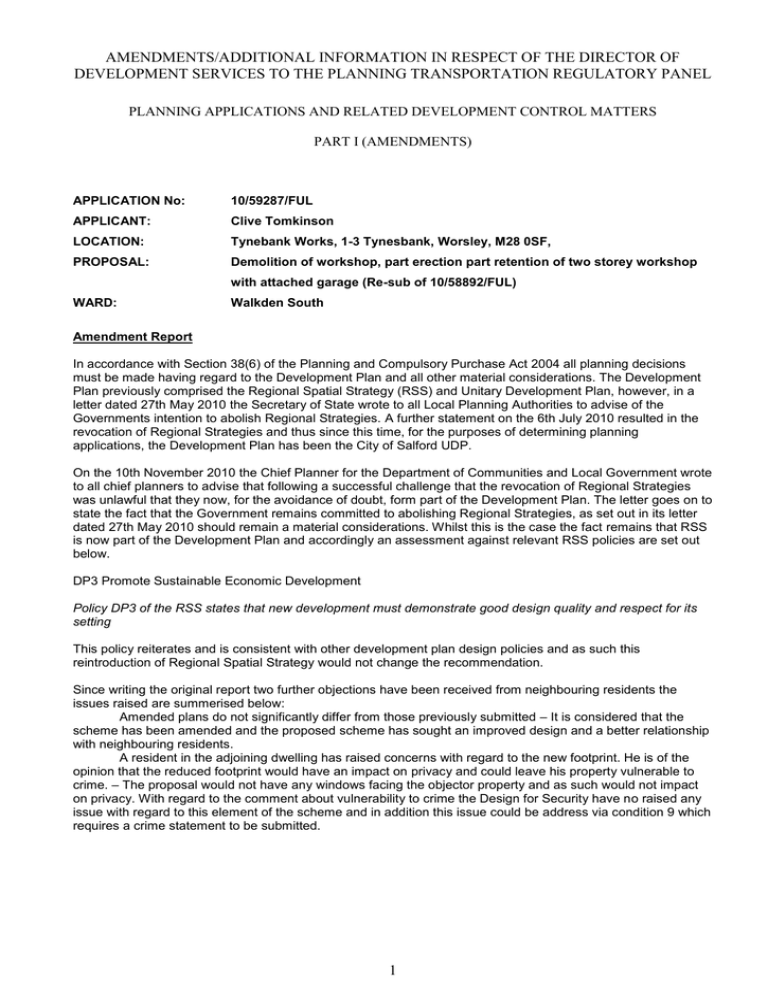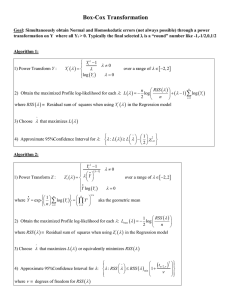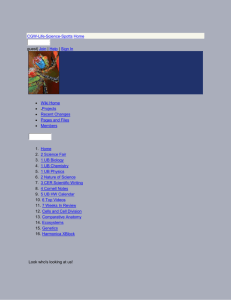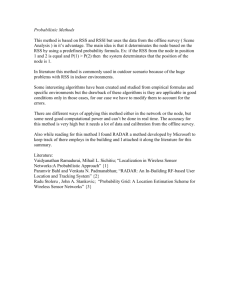AMENDMENTS/ADDITIONAL INFORMATION IN RESPECT OF THE DIRECTOR OF
advertisement

AMENDMENTS/ADDITIONAL INFORMATION IN RESPECT OF THE DIRECTOR OF DEVELOPMENT SERVICES TO THE PLANNING TRANSPORTATION REGULATORY PANEL PLANNING APPLICATIONS AND RELATED DEVELOPMENT CONTROL MATTERS PART I (AMENDMENTS) APPLICATION No: 10/59287/FUL APPLICANT: Clive Tomkinson LOCATION: Tynebank Works, 1-3 Tynesbank, Worsley, M28 0SF, PROPOSAL: Demolition of workshop, part erection part retention of two storey workshop with attached garage (Re-sub of 10/58892/FUL) WARD: Walkden South Amendment Report In accordance with Section 38(6) of the Planning and Compulsory Purchase Act 2004 all planning decisions must be made having regard to the Development Plan and all other material considerations. The Development Plan previously comprised the Regional Spatial Strategy (RSS) and Unitary Development Plan, however, in a letter dated 27th May 2010 the Secretary of State wrote to all Local Planning Authorities to advise of the Governments intention to abolish Regional Strategies. A further statement on the 6th July 2010 resulted in the revocation of Regional Strategies and thus since this time, for the purposes of determining planning applications, the Development Plan has been the City of Salford UDP. On the 10th November 2010 the Chief Planner for the Department of Communities and Local Government wrote to all chief planners to advise that following a successful challenge that the revocation of Regional Strategies was unlawful that they now, for the avoidance of doubt, form part of the Development Plan. The letter goes on to state the fact that the Government remains committed to abolishing Regional Strategies, as set out in its letter dated 27th May 2010 should remain a material considerations. Whilst this is the case the fact remains that RSS is now part of the Development Plan and accordingly an assessment against relevant RSS policies are set out below. DP3 Promote Sustainable Economic Development Policy DP3 of the RSS states that new development must demonstrate good design quality and respect for its setting This policy reiterates and is consistent with other development plan design policies and as such this reintroduction of Regional Spatial Strategy would not change the recommendation. Since writing the original report two further objections have been received from neighbouring residents the issues raised are summerised below: Amended plans do not significantly differ from those previously submitted – It is considered that the scheme has been amended and the proposed scheme has sought an improved design and a better relationship with neighbouring residents. A resident in the adjoining dwelling has raised concerns with regard to the new footprint. He is of the opinion that the reduced footprint would have an impact on privacy and could leave his property vulnerable to crime. – The proposal would not have any windows facing the objector property and as such would not impact on privacy. With regard to the comment about vulnerability to crime the Design for Security have no raised any issue with regard to this element of the scheme and in addition this issue could be address via condition 9 which requires a crime statement to be submitted. 1 APPLICATION No: 10/59297/FUL APPLICANT: Laing O'Rourke Construction North LOCATION: Broadway Industrial Estate, King William Street, Salford, , PROPOSAL: Demolition of former Salford Cental URC building and erection of a 1150 place secondary school and sixth form with associated parking, landscaping and a creation of a vehicular access WARD: Ordsall Amendment Report Regional Spatial Strategy Since writing this report there has been a change to the status of The North West of England Plan Regional Spatial Strategy) (RSS). In accordance with Section 38(6) of the Planning and Compulsory Purchase Act 2004 all planning decisions must be made having regard to the Development Plan and all other material considerations. The Development Plan previously comprised the Regional Spatial Strategy (RSS) and Unitary Development Plan, however, in a letter dated 27th May 2010 the Secretary of State wrote to all Local Planning Authorities to advise of the Governments intention to abolish Regional Strategies. A further statement on the 6th July 2010 resulted in the revocation of Regional Strategies and thus since this time, for the purposes of determining planning applications, the Development Plan has been the City of Salford UDP. On the 10th November 2010 the Chief Planner for the Department of Communities and Local Government wrote to all chief planners to advise that following a successful challenge that the revocation of Regional Strategies was unlawful that they now, for the avoidance of doubt, form part of the Development Plan. The letter goes on to state the fact that the Government remains committed to abolishing Regional Strategies, as set out in its letter dated 27th May 2010 should remain a material considerations. Whilst this is the case the fact remains that RSS is now part of the Development Plan and accordingly an assessment against relevant RSS policies is set out below. DP1 – Spatial Principles DP2 – Promote Sustainable Communities DP4 – Make the Best Use of Existing Resources and Infrastructure DP7 – Promote Environmental Quality DP9 – Reduce Emissions and Adapt Climate Change L1 – Health, Sport. Recreation, Cultural and Education Provision RSS policy DP1 sets out a number of principles that underpin the RSS and that all proposals should adhere to. These are as follows: • promote sustainable communities; • promote sustainable economic development; • make the best use of existing resources and infrastructure; • manage travel demand, reduce the need to travel, and increase accessibility; • marry opportunity and need; • promote environmental quality; • mainstreaming rural issues; • reduce emissions and adapt to climate change It also states that policies DP2 to DP9 amplify the main principles set out in DP1 and that they should be taken together as the spatial principles underlying the strategy of the RSS. RSS policy DP2 relates to the promotion of sustainable communities and states that building sustainable communities – places where people want to live and work – is a regional priority. Sustainable communities 2 should meet the diverse needs of existing and future residents, promote community cohesion and equality and diversity, be sensitive to the environment and contribute to a high quality of life through a range of measures. RSS policy DP4 states that development should accord with a sequential approach as follows • first, using existing buildings within settlements and previously developed land within settlements; • second, using other suitable infill opportunities within settlements, where compatible with other RSS polices; • third, the development of other land where this is well-located in relation to housing, jobs, other services and infrastructure and which complies with other principles in policies DP1-9. RSS policy DP5 relates to managing travel demand; reducing the need to travel and increasing accessibility and states that development should be located to reduce the need to travel, especially by car, and to enable people as far as possible to meet their needs locally. All new development should be genuinely accessible by public transport, walking and cycling, and priority will be given to locations where such access is already available. RSS policy DP7 states that environmental quality should be protected and enhanced through a range of measures that include: • respecting the character and distinctiveness of places; • the protection and enhancement of the historic environment; • promoting good quality design in new development; • maximising opportunities for the regeneration of derelict or dilapidated areas; • assessing the potential impacts of managing traffic growth and mitigating the impacts of road traffic on air quality, noise and health. RSS Policy L1 (Health, Sport, Recreation, Cultural and Education Services Provision) states that ‘plans, strategies, proposals and schemes (including those of education, training and health service providers) should ensure that there is provision for all members of the community (including older people, disabled people and the black & minority ethnic population) for: • the full spectrum of education, training and skills provision, ranging from childcare and pre-school facilities, through school, to further and higher education and to continuing education facilities and work-related training; • health facilities ranging from hospitals down to local based community health facilities; and • sport, recreation and cultural facilities’. The policy seeks the views/needs of the local community as well as the accessibility of the site to public transport, walking and cycling. With respect to the above policies and as detailed in the main report. The principle of a school on this site has been established through previous planning permissions the most recent of which was considered against the current RSS. The proposal involves the re-use of previously developed land and is therefore in line with the sequential approach to development set out in RSS Policy DP4. The application site is located in close proximity to good transport routes that are serviced by various methods of public transport and the site is accessible by both car and bicycle. The proposed development site is therefore considered to be in a sustainable location in accordance with the above policies. RSS policy DP9 relates to reducing emissions and adapting to climate change and states that proposals should contribute to these aims through a range of measures that include: As a result, the proposal achieves a very good rating as detailed in the main appraisal. It is therefore considered to be in accordance with the national, regional and local policies relating to climate change and sustainability. 3 Conditions Please see revised conditions below: the conditions have been revised to ensure the development can commence on schedule. 11. Prior to first occupation full details of the location and design of cycle, refuse and recycling storage areas within the site shall be submitted to and approved in writing by the Local Planning Authority. Such storage areas shall be constructed in accordance with the approved details and shall be made available for use prior to the first occupation of the development hereby approved. 23. Notwithstanding the details submitted on the following plans: PLL-L006 Rev B -Planting Strategy and PLL-L002 Rev E - Site Plan, prior to first occupation full details of the percentage of plants in hedges; location of plants along Trafford Road; samples and specification of external surfaces and a detailed specification of the proposed planter to the north of the site shall be submitted to and agreed in writing by the Local Planning Authority unless otherwise agreed in writing. The approved scheme shall be carried out within 12 months of the commencement of development. Any trees or shrubs dying within five years of planting shall be replaced with the same species within twelve months. 25. Prior to first occupation a scheme for the provision of external lighting shall be submitted to and approved in writing by the Local Planning Authority. Such a scheme shall include full details of the locations, design, luminance levels, light spillage and hours of use of, and columns for, all external lighting within the site the approved scheme shall be implemented in full prior to the occupation of development. 26. The development hereby permitted shall be carried out in accordance with the following approved plans. Unless otherwise agreed in writing by the Local Planning Authority: OA_AED_PL_001 OA_AED_PL_002 OA_AED_PL_003 OA_AED_PL_004 OA_AED_PL_005 OA_AED_PL_006 OA_AED_PL_007 OA_AED_PL_008 PLL-L000 Rev A PLL-L001 Rev B PLL-L002 Rev G PLL-L004 Rev B PLL-L006 Rev B PLL-L-007 Rev A Shadow Study Lower Ground Floor Plan Upper Ground Floor Plan First Floor Plan Second Floor Plan Roof Plan Elevations Sheet 1 of 2 Elevations Sheet 2 of 2 Site Location Plan BB98 Drawing Site Plan Site Sections Planting Strategy Tree Removal Plan 27. Prior to first occupation a landscaping and building management scheme shall be submitted to and approved in writing by the Local Planning Authority. The scheme shall detail the maintenance regime for all areas of landscaping (hard and soft) and the external elevations of the buildings. The approved management scheme shall be implemented in full in accordance with the approved details and shall be retained at all times thereafter unless otherwise agreed in writing by the Local Planning Authority. 28. Unless otherwise agreed in writing prior to commencement of development save for site clearance and remediation full details including the siting and appearance of the proposed sub station and associated plant machinery shall be submitted to and approved in writing by the Local Planning Authority. The scheme shall be built in accordance with the approved details. 4 APPLICATION No: 10/59319/FUL APPLICANT: Great Places LOCATION: Land Off South Side Of Mill Street, Boothstown, M28 1SG PROPOSAL: Erection of 15no. dwelling houses comprising of 7no. two bedroom units and 8no. three bedroom units with associated fencing and landscaping, WARD: Boothstown And Ellenbrook Amendment Report With regard to consultations additional information has been received from Urban Vision Environment. The Conservative Club is a source of entertainment noise and there is a function room available for use. The nearest of the proposed dwellings is approximately 12m from the rear yard wall of the club. However, this dwelling's gable end faces the Club premises and there are no windows to habitable rooms in the gable end. Furthermore, a boundary fence is proposed at the side of the dwelling and this will offer a degree of noise protection. It is probable that on occasions entertainment noise from the Club will be audible on the development site, but this is no reason to object to the proposed housing development. Six further letters have been received by neighbours and a number of new issues have been raised. a) the overall standard of design is not good; the Council's own guidelines on privacy distances are not met, block A turns its back on the rest of the development, the central parking area is a wide expance of tarmac, no pre-application discussion has taken place with the planning department and the applicant has not sought the views of residents - It is not good planning. b) residents are not against development but just do not think this is the right development - a good and reasonable development would be welcomed c) that the issue of parking on Mill Street will inevitably lead to confusion and confrontation between existing and future residents d) what effect will the development have on the residents of Mill street with regard to security and safety e) what S106 contribution is being made f) Mill St residents have had an open aspect to the south for more than 100 years, surely this cannot just be removed so easily g) the current owner has allowed unrestricted parking on the site for many years and there has never been any notice put up restricting this. h) Since 1946 there has been an un-opposed track from the end of Mill Street to the gap in the buildings adjacent to the Conservative Club, at what point does this become a public right of way? i) the site is historically significant and is the site of a former windmill j) while the need for affordable homes is recognised the site layout has changed little and is not suitable k) the changes made to facilitate bin collection will not work in practice l) the development will lead to increased parking on the main road, the A577, inevitably making it more dangerous m) that the application site includes land outside of the ownership of Mr Silcock n) that the submitted plans fail to show the true length of Mill Street. In response to these additional comments made by neighbours the following points are made: a) whilst there are elements of the design that could be improved upon (such as the fact that as a consequence of turning block A so that it faces Mill St it now turns iits back on the rest of the development) these are not considered sufficient to outweigh the merits of the application. The issue of privacy distances has already been addressed. Whilst it is regrettable that pre-application discussions with planning officers were not held and that neighbours were not first consulted by the applicant these are not reasons in themselves for refusing planning permission. With regard to whether or not this is good planning it is acknowledged that this is a difficult site and that certain aspects could be improved upon. However, a judgement has been made that the merits of the application outweigh the applications shortcomings and therefore the balance falls on the side of approval rather than refusal in this instance. b) this point is noted 5 c) this issue has been addressed in the main report d) with regard to security and safety it is considered that new houses on the street would provide additional surveillance that would result in improved security and safety for existing residents e) this point is dealt with in the main report f) this point is dealt with in the main report g) this point is noted h) the issue of whether a public right of way or not is seperate to the planning considerations but, if residents were to demonstrate that such a public right of way existed and that it could not be diverted then the application could not proceed in its current form. i) the Greater Manchester Archaeology Unit has been consulted but no response has been received to date. It is hoped that this point can be dealt with verbally but it may be necessary to attach a condition requiring a survey and photographic record of the former windmill to be made. j) this point has been addressed above k) this point is noted but the point has been addressed in the main report l) this point is noted but it is pointed out that there are no objections on highway grounds to the scheme. m) this point is not relevant to the planning considerations n) this point is noted and was pointed out to members who attended the site visit. Since writing this report there has been a change to the status of Regional Spatial Strategy (RSS). In accordance with Section 38(6) of the Planning and Compulsory Purchase Act 2004 all planning decisions must be made having regard to the Development Plan and all other material considerations. The Development Plan previously comprised the Regional Spatial Strategy (RSS) and Unitary Development Plan, however, in a letter dated 27th May 2010 the Secretary of State wrote to all Local Planning Authorities to advise of the Government's intention to abolish Regional Strategies. A further statement on the 6th July 2010 resulted in the revocation of Regional Strategies and since then, for the purposes of determining planning applications, RSS has not formed part of the Development Plan. On the 10th November 2010 the Chief Planner at the Department of Communities and Local Government wrote to all local authority chief planners to advise that, following a successful court challenge, the revocation of Regional Strategies was unlawful and that they now, for the avoidance of doubt, form part of the Development Plan. The letter also stated that the Government remains committed to abolishing Regional Strategies, as set out in its letter dated 27th May 2010 and that this should remain a material consideration. DP1 - Spatial Principles DP2 - Promote Sustainable Communities DP4 - Make the Best Use of Existing Resources and Infrastructure DP7 - Promote Environmental Quality DP9 - Reduce Emissions and Adapt Climate Change RDF1 - Spatial Priorities MCR1 - Manchester City Region Priorities MCR2 - Regional Centre and Inner Areas of Manchester City Region L4 - Regional Housing Provision RSS policy DP1 sets out a number of principles that underpin the RSS and that all proposals should adhere to. These are as follows: - promote sustainable communities; - promote sustainable economic development; - make the best use of existing resources and infrastructure; - manage travel demand, reduce the need to travel, and increase accessibility; - marry opportunity and need; - promote environmental quality; - mainstreaming rural issues; - reduce emissions and adapt to climate change It also states that policies DP2 to DP9 amplify the main principles set out in DP1 and that they should be taken together as the spatial principles underlying the strategy of the RSS. 6 RSS policy DP2 relates to the promotion of sustainable communities and states that building sustainable communities - places where people want to live and work - is a regional priority. Sustainable communities should meet the diverse needs of existing and future residents, promote community cohesion and equality and diversity, be sensitive to the environment and contribute to a high quality of life through a range of measures. RSS policy DP4 states that development should accord with a sequential approach as follows - first, using existing buildings within settlements and previously developed land within settlements; - second, using other suitable infill opportunities within settlements, where compatible with other RSS polices; - third, the development of other land where this is well-located in relation to housing, jobs, other services and infrastructure and which complies with other principles in policies DP1-9. RSS policy DP5 relates to managing travel demand; reducing the need to travel and increasing accessibility and states that development should be located to reduce the need to travel, especially by car, and to enable people as far as possible to meet their needs locally. All new development should be genuinely accessible by public transport, walking and cycling, and priority will be given to locations where such access is already available. RSS policy DP7 states that environmental quality should be protected and enhanced through a range of measures that include: - respecting the character and distinctiveness of places; - the protection and enhancement of the historic environment; - promoting good quality design in new development; - maximising opportunities for the regeneration of derelict or dilapidated areas; - assessing the potential impacts of managing traffic growth and mitigating the impacts of road traffic on air quality, noise and health. With respect to the above policies and as detailed in the main report the proposal involves the re-use of previously developed land and is therefore in line with the sequential approach to development set out in RSS Policy DP4. The application site is located in close proximity to good transport routes and the site is accessible by both car and bicycle. The proposed development site is therefore considered to be in a sustainable location in accordance with the above policies. RSS policy DP9 relates to reducing emissions and adapting to climate change and states that proposals should contribute to these aims through a range of measures. As set out in the main report the proposal will achieve a good Code for Sustainable Homes rating. It is therefore considered to be in accordance with policy DP9. RSS policy RDF1 states that the Regional Centre of Manchester/Salford is the first priority growth area. RSS policy MCR1 states that plans and strategies should support significant improvement in the sub-region’s economic performance through encouraging investment. RSS policy MCR2 specifies the primacy of the Regional Centre in driving the economy and need for investment in business, retail, housing, leisure, culture and tourism, and the knowledge economy. This policy also confirms that the whole application site is within the defined Regional Centre. RSS policy L4 sets regional housing requirements, with Salford having an annual requirement for 1,600 dwellings per annum, with at least 90% delivered from previously developed land. It further alludes to the need to support Housing Market Renewal Initiatives, active in the central area of Salford and providing homes that meet new and future standards for lifetime homes and flexible living, in addition to reducing carbon emissions and energy use under the Code for Sustainable Homes. Finally the applicant has pointed out that the homes are for sale on a shared ownership basis and that Homes and Communities Agency rules allow people, over time, to own their homes outright, this is known as staircasing. Therefore condition 9 is inappropriate. Housing colleagues have confirmed that this is the case and the condition has now been removed. 7 APPLICATION No: 10/59373/FUL APPLICANT: Mr R Docherty LOCATION: 2 Ellerby Avenue, Clifton, Swinton, M27 8LA, PROPOSAL: Erection of two detached dormer bungalows (Re-Sub of 10/59003/FUL) WARD: Pendlebury Amendment Report In accordance with Section 38(6) of the Planning and Compulsory Purchase Act 2004 all planning decisions must be made having regard to the Development Plan and all other material considerations. The Development Plan previously comprised the Regional Spatial Strategy (RSS) and Unitary Development Plan, however, in a letter dated 27th May 2010 the Secretary of State wrote to all Local Planning Authorities to advise of the Governments intention to abolish Regional Strategies. A further statement on the 6th July 2010 resulted in the revocation of Regional Strategies and thus since this time, for the purposes of determining planning applications, the Development Plan has been the City of Salford UDP. On the 10th November 2010 the Chief Planner for the Department of Communities and Local Government wrote to all chief planners to advise that following a successful challenge that the revocation of Regional Strategies was unlawful that they now, for the avoidance of doubt, form part of the Development Plan. The letter goes on to state the fact that the Government remains committed to abolishing Regional Strategies, as set out in its letter dated 27th May 2010 should remain a material considerations. Whilst this is the case the fact remains that RSS is now part of the Development Plan and accordingly an assessment against relevant RSS policies are set out below. DP3 Promote Sustainable Economic Development DP4 - Make the Best Use of Existing Resources and Infrastructure Policy DP3 of the RSS states that new development must demonstrate good design quality and respect for its setting This policy reiterates and is consistent with other development plan design policies and as such this reintroduction of Regional Spatial Strategy would not change the recommendation for refusal. RSS policy DP4 states that development should accord with a sequential approach as follows - first, using existing buildings within settlements and previously developed land within settlements; - second, using other suitable infill opportunities within settlements, where compatible with other RSS polices; - third, the development of other land where this is well-located in relation to housing, jobs, other services and infrastructure. With respect to the above policies and as detailed in the main report the proposal involves the re-use of previously developed land and is therefore in line with the sequential approach to development set out in RSS Policy DP4. The application site is located within an existing settlement and in close proximity to good transport routes and the site is accessible by both car and bicycle. The proposed development site is therefore considered to be in a sustainable location and accord with RSS policy DP4. 8 APPLICATION No: 10/59388/FUL APPLICANT: Mr Stephen Snowdon LOCATION: 27 - 47 Birchfield Drive And , Land Adjacent To 33 Simpson Grove, Boothstown, Worsley, M28 1ND, PROPOSAL: Removal of waste material from the rear gardens of 33-45 Birchfield Drive including the demolition and rebuilding of single storey rear extensions at 3945 Birchfield Drive; installation of impermeable barrier trench to the rear of 27 to 47 Birchfield Drive; installation of vent trench to northern end of Simpson Grove adjacent to 33 Simpson Grove; and associated contractors compound., WARD: Boothstown And Ellenbrook Amendment Report In accordance with Section 38(6) of the Planning and Compulsory Purchase Act 2004 all planning decisions must be made having regard to the Development Plan and all other material considerations. The Development Plan previously comprised the Regional Spatial Strategy (RSS) and Unitary Development Plan, however, in a letter dated 27th May 2010 the Secretary of State wrote to all Local Planning Authorities to advise of the Governments intention to abolish Regional Strategies. A further statement on the 6th July 2010 resulted in the revocation of Regional Strategies and thus since this time, for the purposes of determining planning applications, the Development Plan has been the City of Salford UDP. On the 10th November 2010 the Chief Planner for the Department of Communities and Local Government wrote to all chief planners to advise that following a successful challenge that the revocation of Regional Strategies was unlawful that they now, for the avoidance of doubt, form part of the Development Plan. The letter goes on to state the fact that the Government remains committed to abolishing Regional Strategies, as set out in its letter dated 27th May 2010 should remain a material considerations. Whilst this is the case the fact remains that RSS is now part of the Development Plan and accordingly an assessment against relevant RSS policies is set out below. This development involves the remediation of an area of contaminated land and as such RSS policy EM2 is of relevance - Remediating Contaminated Land. This policy states that remediation technologies should be used to reduce or render harmless any contamination that may be present at a site in order to eliminate any unacceptable risks. The works proposed under this application will remove contaminated material thereby having a positive impact upon the environment and the well being of affected residents in accordance with this policy. 9





